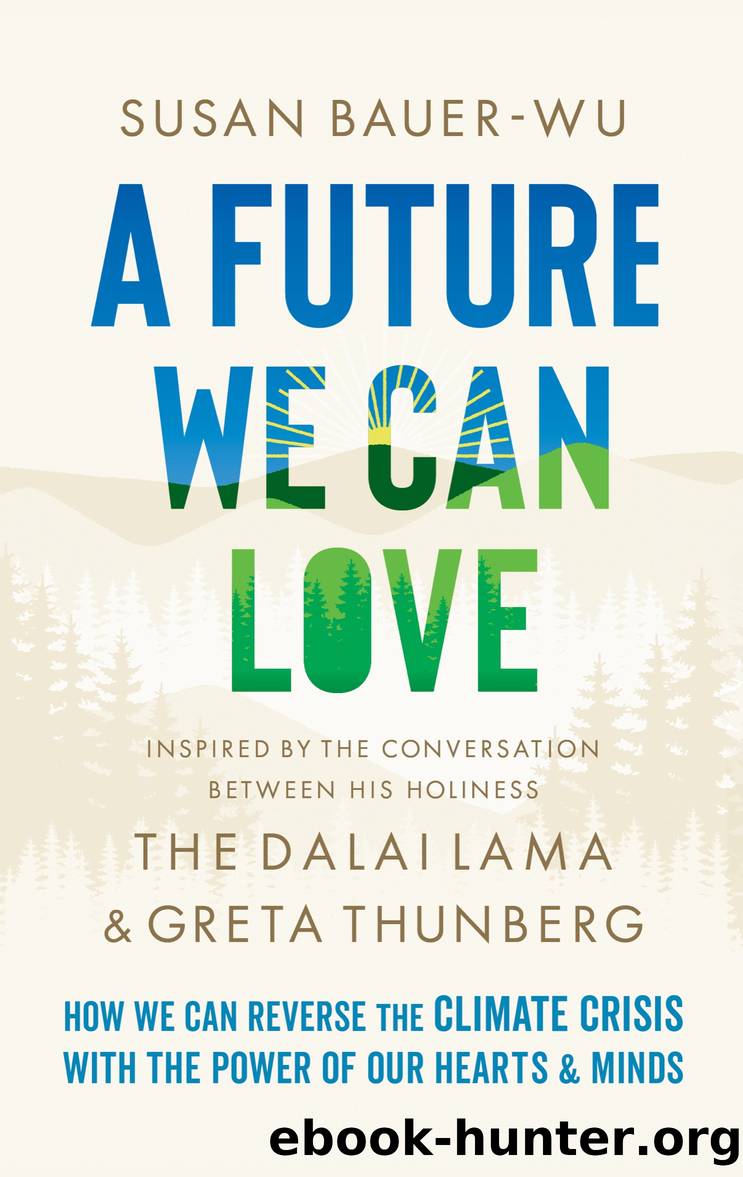A Future We Can Love by Susan Bauer-Wu

Author:Susan Bauer-Wu [Bauer-Wu, Susan]
Language: eng
Format: epub
Publisher: Shambhala
Published: 2023-06-13T00:00:00+00:00
* * *
â
Optimism. Hope. I prefer fewer syllables, other things being equal, and I like that âhopeâ is a verb. But whatever word works for you, we can agree the distinction is important: hoping and working together for a future we can love is definitely not the same thing as counting on it while doing nothing about it.
Katharine Hayhoe says she is asked almost every single day what gives her hope. âIâve turned that around and Iâve asked hundreds of people the same question here in North America and Europe and beyond. I got a lot of different answers, but they all boil down to people seeing other people act, recognizing that we are not alone, recognizing that I as an individual can make a difference through using my voice, through advocating for change in my place of worship, in the place where I work, in my community, in my neighborhood, in my school, in my social organization, as part of my city or state or country.â An evangelical Christian, Katharine is famous for finding ways to engage in dialogue about the climate crisis with people who initially donât want to talk about it at all. Overflowing with clear, practical advice and examples, she is one of the most articulate and compelling climate activists that I have ever heard. The trick, she says, is to talk about what people already care about; thatâs our âin,â because no matter what it is, thereâs a climate angle. Some peopleâs capacity to wake up and change to cleaner energy, for example, starts with saving money, when they see that it will reduce their monthly utilities bill. Meeting people where they are and being willing to work from there strikes me as hope in action. Our motivations can be pretty prosaic, yet Katharine wants us to know that at least for a start, thatâs okay. Whatever it takes.
Lyla June finds hope for the future in learning from the past. She reminds us that the Great Plains of the United States, for example, were created by people in cooperation with nature, not by nature alone. In some Indigenous lunar calendars, she says, âthe September moon is called the Grass Burning Moon, because it was time to burn the plains.â She explains, burning recycles the nutrients of the expired plant tissues by turning it into ash. The ash goes into the soil, bringing potassium, nitrogen, and phosphorus along with it. Burning also creates charcoal that, as Lyla puts it, âcreates little apartment rooms for microbiomes.â So, this kind of controlled burning returns nutrients to the soil, stimulates microbial activity in the soil, supports certain species that only flower after fire, and significantly reduces the chance of uncontrolled wildfires.
If they hadnât burned those prairies, Lyla says, âif you leave the grasslands alone, they will close into shrubs and trees. Grasslands donât live without humans. So, what you have in the wake of these fires is that nutrient-dense grasslands come up, and who loves nutrient-dense grasses? Buffalo. A
Download
This site does not store any files on its server. We only index and link to content provided by other sites. Please contact the content providers to delete copyright contents if any and email us, we'll remove relevant links or contents immediately.
The Way of Zen by Alan W. Watts(6513)
Ego Is the Enemy by Ryan Holiday(5298)
The Art of Happiness by The Dalai Lama(4065)
The Book of Joy by Dalai Lama(3904)
Why Buddhism is True by Robert Wright(3406)
Spark Joy by Marie Kondo(3253)
Shift into Freedom by Loch Kelly(3140)
Happiness by Matthieu Ricard(2996)
A Monk's Guide to a Clean House and Mind by Shoukei Matsumoto(2870)
The Lost Art of Good Conversation by Sakyong Mipham(2580)
The Meaning of the Library by unknow(2508)
The Unfettered Mind: Writings from a Zen Master to a Master Swordsman by Takuan Soho(2250)
The Third Eye by T. Lobsang Rampa(2227)
Anthology by T J(2165)
Red Shambhala by Andrei Znamenski(2154)
The Diamond Cutter by Geshe Michael Roach(2023)
Thoughts Without A Thinker: Psychotherapy from a Buddhist Perspective by Epstein Mark(1966)
Twilight of Idols and Anti-Christ by Friedrich Nietzsche(1854)
Advice Not Given by Mark Epstein(1840)
